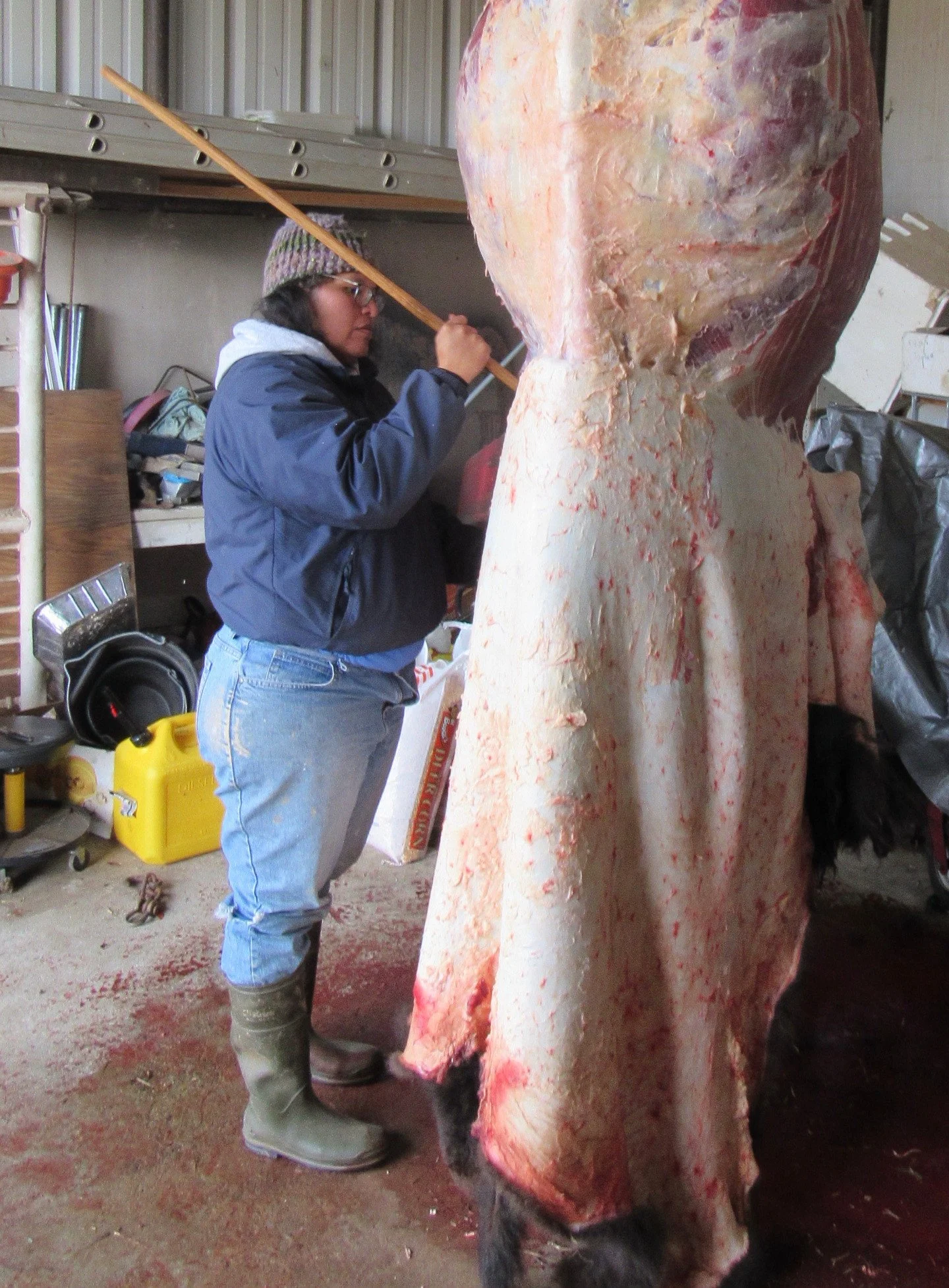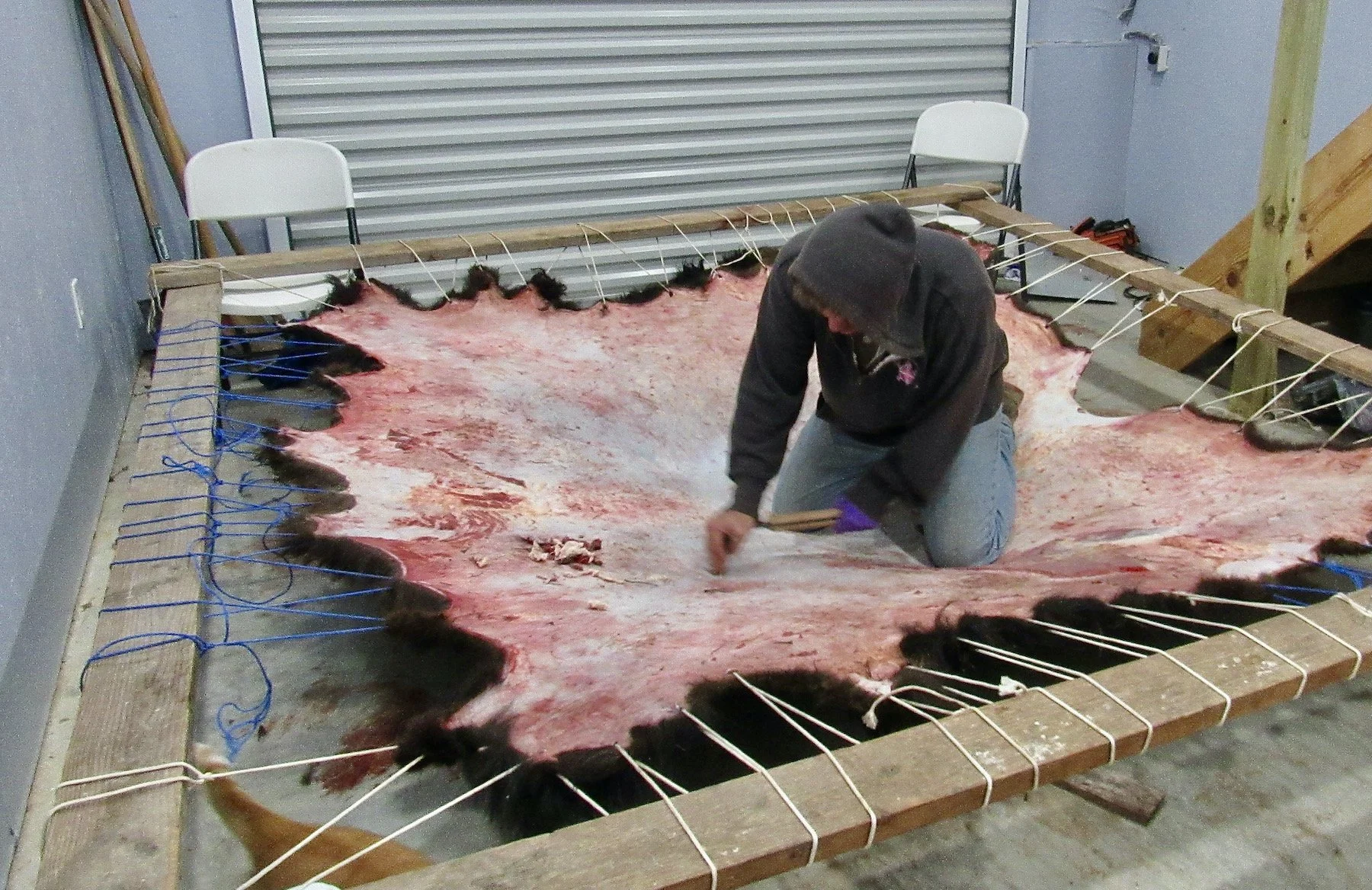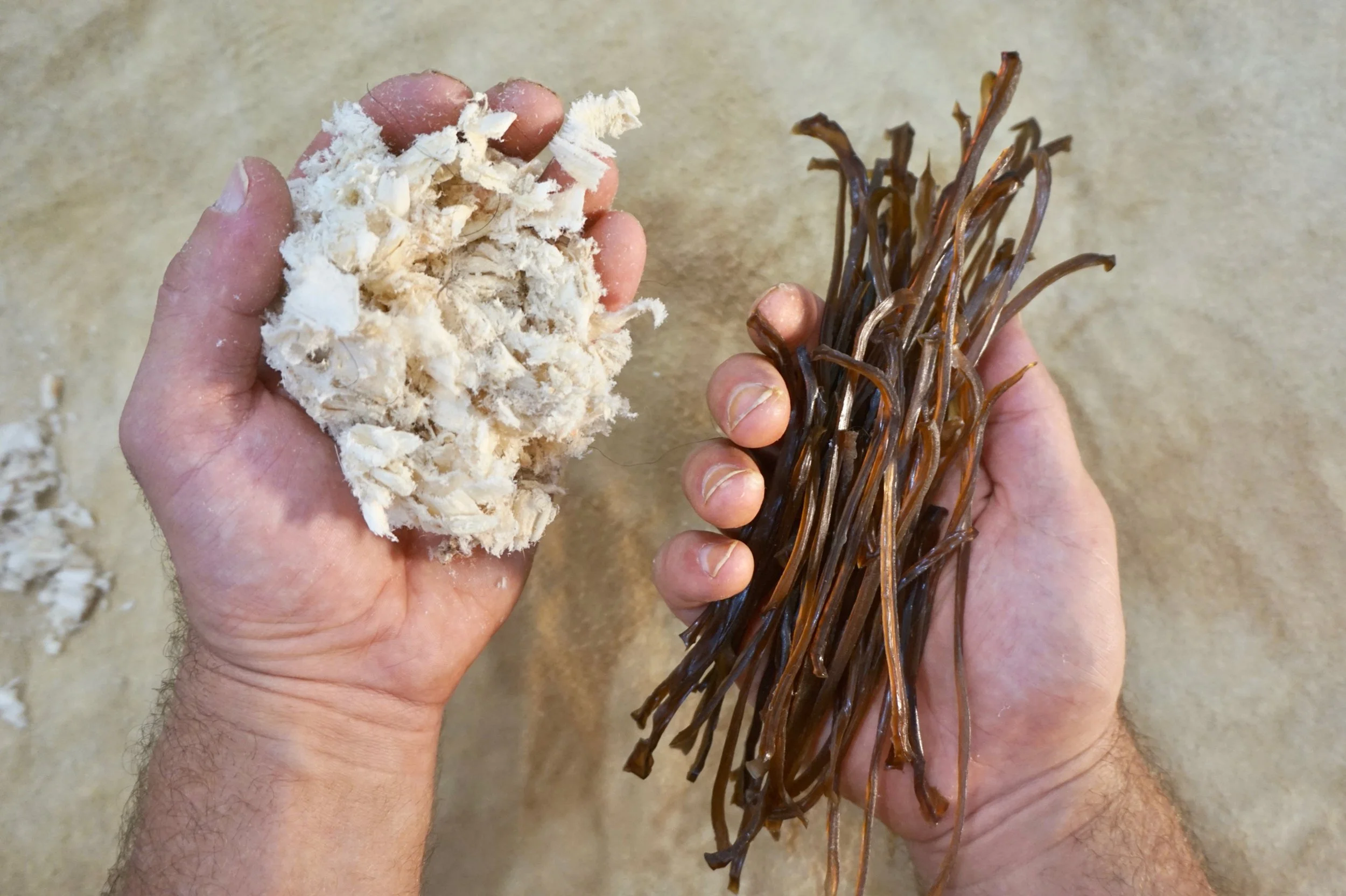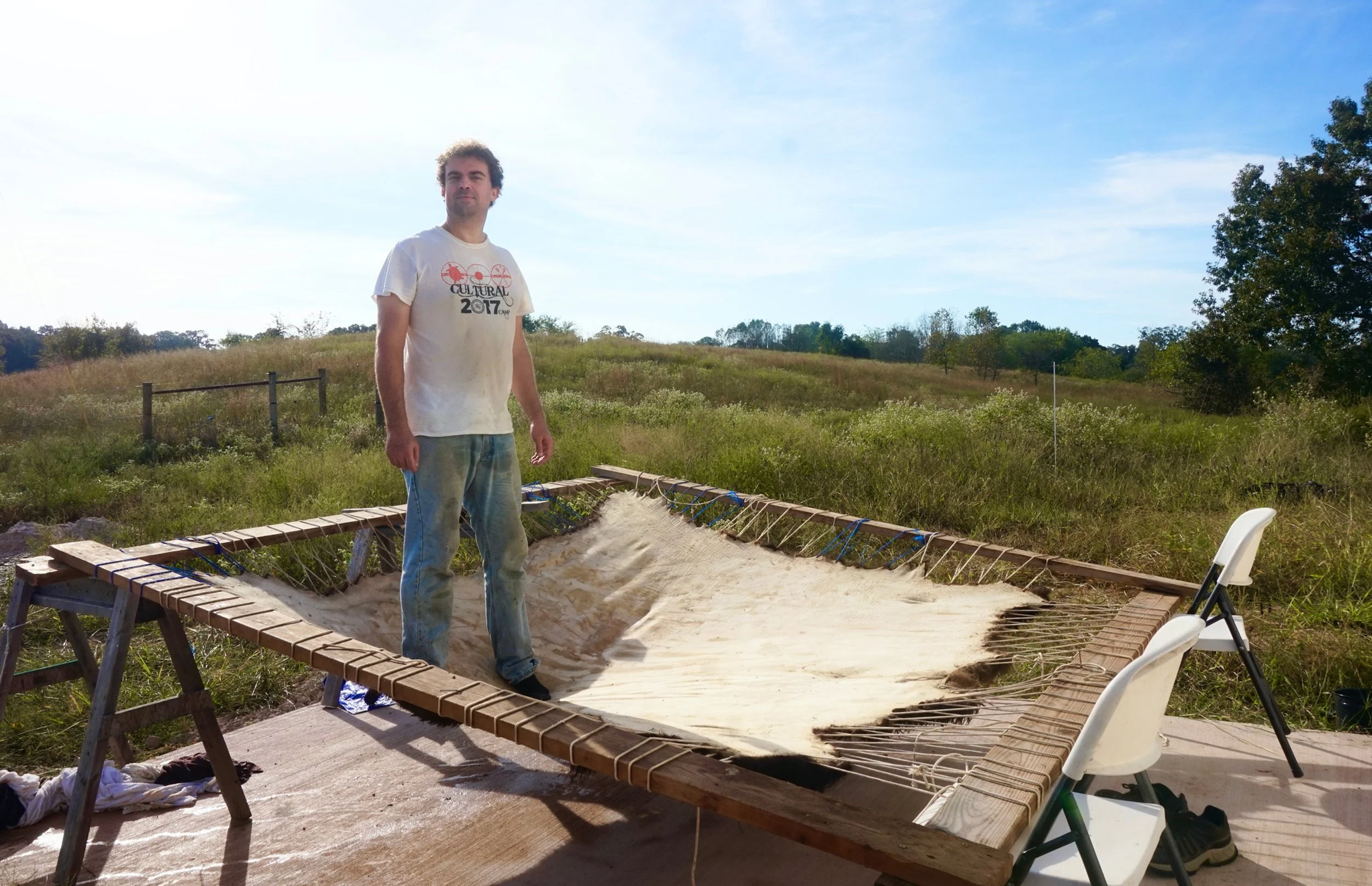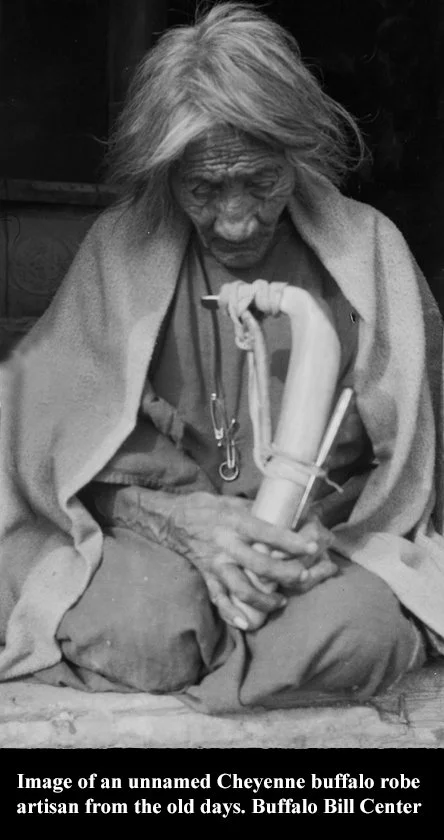Brain Tanning a Buffalo Robe
A traditionally tanned buffalo robe is something pretty special. If any single thing can embody the connection between people, the prairie, and traditional culture, this is it. The bison is part of the very essence of the American prairie. As a keystone species, this animal helped to shape this landscape. As a cultural keystone species, it also provided resources needed by the region's Indigenous communities to thrive. For approximately 99% of the time that humans have been living on the American prairies, robes made out of hair-on buffalo hide were a ubiquitous item of clothing, worn by both men and women. Countless human stories have unfolded here with their main actors wearing buffalo robes, or at least with buffalo robes somewhere on the scene. The art of transforming the cold, slimy skin of a freshly butchered buffalo into a soft, warm, wonderful-smelling garment is nothing short of magic. This magic was perfected and passed down by 500+ generations of Native American people who lived on the prairie/Plains. The traditional hide-tanning process connects the tanner with the animal in a way that little else could. It takes hours and days of exertion to soften a buffalo hide. During the process, as your heart races and your breathing increases, you inhale the sweet, distinctive scent of the buffalo wool along with the tiny fibers of hide that shred off as you work. As your sweat soaks into the hide, you become a part of it.
Dateline - a dark January night in rural Kansas, 2002. Czech opera music (a friend's selection) blares out into the black stillness as a crackling bonfire flickers light onto the carcass of a yearling buffalo hung from a tree by one back foot - The bizarre setting where I skinned out my first buffalo robe is a scene that will probably never be repeated again should humanity last a billion years. - That morning, my friend Matt and I left school to go to the buffalo farm near Moberly, Missouri, to buy some meat to take to his family. When we got there, they had just put down a blind yearling and offered the whole thing to us for not much more than we had planned to spend on a few roasts. The carcass didn't quite fit into the bed of Matt's Ford Ranger, so two buffalo legs rode on the side of the bed, bouncing up and down for the 350-mile trip to his family's place. Other drivers changed speed on I-35 to try to figure out what we were carrying. The eerie fire-lit scene described above came together as we arrived and got set up to process the animal as quickly as possible with the help of Matt's brother. We treated the animal with respect and skinned it in the old way using a bone fleshing tool. After a weekend of butchering, my friends' family got a couple hundred pounds of prime meat, and I took home a prime hide. I scraped the flesh side of that hide and then spent 10 full days alternately applying brains to the flesh side and trying to soften it. Drawing more on brute force than knowledge, I eventually manhandled the leather into pliability, but I never got the skin side as soft as many of the robes done by more experienced buffalo hide tanners.
Since that experience, I had brain/egg-tanned quite a few hides, 130 of them in fact, deer and many other native species. Never another buffalo robe, though. There are at least three active traditional tanners who have each braintanned hundreds of buffalo robes, but the number of living people who have successfully braintanned a buffalo robe is very small. Buffalo robe tanning is arguably one of the more threatened traditional arts. Part of the reason there are few buffalo robe tanners is that robe tanning is a demanding job, and before a perspective tanner can even get to doing it, he or she first has to acquire a good hide, a big enough work space, a sufficient block of time, and the requisite tanning experience and physical endurance to successfully pull it off.
For me, the elusiveness of braintanning a buffalo robe became just another part of its allure. For more than a decade after my first experience, it was not possible to obtain another high quality buffalo hide, skinned in the right way to make a traditional robe. Even after Amy and I started raising and butchering buffalo, we still lacked the space to tan a buffalo robe indoors, and it was not possible to get enough days off work with the right temperature and humidity to do it outdoors. In 2019, when we built our little home on the range, we dedicated 1/4 of our floor space to a shop that is literally designed around a buffalo hide frame. This fall, I finally got a chance -19 years in the making, to tan a second buffalo robe.
The robe that I have had the privilege of tanning this fall came from Spike, a 2-year-old bull. He was born on Nan Awaya Farm (where all of our young bulls are named "Spike"), and lived every day of his life on its landscapes. Last winter, when he reached butchering size, his meat and organs went to feed several households, including our own. His horns were carved into spoons. His massive back and leg tendons were saved to make into bowstrings. Spike's bones are being saved to make into tools and pottery temper. - It may sound a little strange for me to talk about using an animal that we knew in this way, but even the most processed meat product comes from the death of an animal. By having known this animal personally, we are aware of that sacrifice. Respectfully making the best use out of every part of Spike, including his hide, honors him.
Our butcher let Amy and me take the hide off ourselves, cutting the skinning incisions over the outside of the elbows to give the hide that old rectangular (rather than hourglass) shape, and cutting up the back side of the back legs to give the hide a strong edge. Incisions made, we spent three hours peeling the hide off using a beveled hickory stick each, so as not to make a single knife mark in it. This is what Amy is doing in the picture above.
I laced the gorgeous hide onto a frame, suspended horizontally, knelt on top of it, and removed the membrane from the flesh side using an elbow scraper. Buffalo bulls have thick hides. To soften one of them into a robe, you first have to use the scraper to thin away most of the dermis down to just a thin layer attached to the epidermis. I thinned some parts of Spike's hide from 1/2 inch thick down to 1/8 inch.
Hides have natural glue in them. I saved the hide scrapings that I made as a byproduct of thinning the hide. Amy and I rendered these into a lifetime's supply of hide glue for putting arrows together. In this image, the left hand holds some hide scrapings made by thinning this robe; the right hand holds dried strips of translucent, amber-colored hide glue processed out of other shavings from this same hide. Someday, we'll share a how-to post on the alchemy of traditional glue-making.
The natural glue within a fresh hide will cause it to dry into hard, stiff, rawhide unless someone tans it to prevent that from happening. I made a dressing solution out of Spike's brain, bone marrow, and warm water, and applied it to the thinned hide. The emulsified oils in these materials soak into the hide and coat its inner-most fibers. If the hide is worked in the right way as it dries, so that the hide fibers slide back-and-forth past each other, the dressing solution prevents glue bonds from forming between them, allowing the hide to dry soft. On something like a buffalo robe, it takes multiple applications of dressing solution and multiple episodes of softening the hide to get it to come out soft.
I applied the dressing solution to Spike's thinned hide while it was still laced into the frame. After letting it soak in overnight, I propped up the edge of the frame up and started pushing and sliding the edge of a shovel against with flesh side of the hide as hard as I could. When the hide was no longer wet to the touch, I climbed on it and walked around, even trampolined a bit, to get those hide fibers stretching and sliding past each other. When the hide dried to the point of starting to become stiff, I applied another round of dressing solution, and worked the hide until it fully dried. Then, I waited for the next sunny weekend.
Spike's hide took seven rounds of dressing solution and seven separate days of softening to complete. A buffalo doesn't have enough brain material to tan its own massive hide, so I switched over to a solution of egg yolks and animal oil for later applications. As the hide got closer to being soft, I periodically took it out of the frame and vigorously pulled the heavy behemoth back and forth across a vertically suspended aircraft cable to help soften it (image below).
As work progressed, I picked all of the cockle burs out of Spike's wool. Then, we gave the wool a good wash with a garden hose and half a bottle of shampoo. After the second-to last softening, when the hide had become pliable, I took it off of the frame and we sewed it up into a giant bag to suspend it over a smoke pit for a few hours. Inside the pit, I had placed chunks of rotten oak wood on top of a layer of hot coals to smolder. The smoke locks in the leather's softness, protects it from getting eaten, and gives it a nice color and an amazing smell. Then, one last application of tanning solution. On the final softening, I alternated spending one hour pulling the hide back and forth over the cable, and one hour letting the hide rest, for 29 hours. For a hide-tanner, this is the hardest work you'll ever love.
I'm pleased with how this buffalo robe turned out. It's respectably soft, pretty enormous, and exceptionally warm. The tanning job is easily better than on the first robe I did, but there is still opportunity for improvement.
The personal connections that this robe embodies run deep. We knew this animal, and he was part of a herd that is helping us to restore the native landscapes of Nan Awaya Farm. Occasionally as they move across these pastures, this herd will kick stone artifacts out of the dirt that were left here by buffalo-hunters, who followed ancient herds along these same hills and seeps 6,000 years ago. Were they the last people to tan a buffalo robe on this piece of land up until this fall?... Possibly, and if so, what a humbling connection. In addition to being part of the heritage of this land, buffalo robes are also a part of our own heritage. During the 1600s and early 1700s, buffalo herds expanded their range from the Plains down into eastern Mississippi. Choctaw people living there hunted them and tanned their hides into robes, called yvnnvsh hakshup in the Choctaw language. The Chickasaw people (the Choctaws' northern neighbors and Amy's maternal line) seem to have been involved even more in buffalo robe tanning during that period, developing a buffalo hide-working industry that is recognizable archaeologically.
For most Native American communities (Choctaws of the past100+ years being an exception), hide-tanning was usually done by women. In the old days, Native ladies, some of them a fraction of my size and weight, tanned higher quality buffalo robes than I probably ever will. They had physical strength to be sure, but they also had highly sophisticated hide-tanning knowledge and skill. At one point in the lengthy robe-softening process, a part of Spike's hide was stiffer than I would have liked for it to have been at that stage. When you move a stiff hide, it makes a bit of noise; well-softened hides don't. In my mind, I could see a group of those experienced tanners from an earlier age stop by from beyond the grave to check on my progress. As the others watch, one of them reaches out her talented hand towards that stiff spot on the hide. Is she going to show me a trick that old-time tanners used to fix challenging areas like that? She taps a finger against it...thunk, thunk, thunk, thunk, thunk...like a powwow drum. The old-time tanners laugh at me and disappear. Without uttering a word, they have let me know that part of the hide could have been thinned a little more. This is the way Native artisans taught in the old days - providing a learning environment where the initiative to learn was up to the student.
The experience of tanning this robe certainly taught me a little bit more of what the old-time tanners knew. I learned how thin the flesh part of the robe needs to be in order for it to easily soften. I also learned that when holes accidentally get popped through a hide by the scraper during the thinning process, they're very easy to fix, and don't even show up on the finished product. Perhaps most importantly, I started to gain an understanding for what a properly-done buffalo robe is supposed to feel like at the different stages of the tanning process.
With a herd on the farm, and now with a space to tan, I'm optimistic that the chance to tan buffalo robe #3 will come in significantly less than another 19 years. Next time, I'll be able to apply the new things I learned during this experience to make a little bit better finished product with a little bit less work. In the meantime, we'll enjoy being under this warm, cozy buffalo robe this winter, humbled by all of the connections with culture, earlier generations, and the land that this robe embodies.
